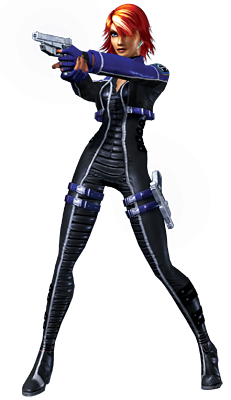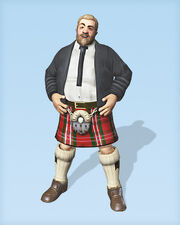
Concept and Design
Perfect Dark was developed by Rare and originally directed by Martin Hollis as a spiritual successor to the company's 1997 first-person shooter GoldenEye 007. Shortly after GoldenEye 007 was released, Rare was planning to work on a game based on the GoldenEye sequel Tomorrow Never Dies, but the company was outbid by Electronic Arts, which would release their video game adaptation in 1999. The result did not affect the developers, who felt they had already spent too much time immersed in the James Bond universe. Working titles for the game included "Covert Ops" and "Alien Intelligence" before the words "Perfect Dark" were decided on. The word "Dark" was chosen for its association with the game's bleak focus on killing. Hollis noted naming similarities to the 2006 first-person shooter Black by Criterion Games: "Game developers just like black, nihilism, dystopian futures, the number zero, infinity, spheres, perfection—all that kind of stuff". The double slash symbol in the game's logo was inspired by the Japanese writing system,while the bad grammar of the phrase "Perfect Dark" partially alludes to Hollis' affection for the way Japanese developers use English words in their own games and products.
The game's science fiction setting was chosen due to the developers' interest in the genre. Works such as the Ghost in the Shell manga, Elektra comic books, The X-Files television series, the films Blade Runner and Judge Dredd, and the writing of author Philip K. Dick were major influences on the characters, setting and plot. Hollis explained that he and designer David Doak "picked a range of locations we thought would be impressive and architectural, on the model of GoldenEye but sci-fi dystopias The settings came first; the plot was then constructed by Doak to sew them together". The new setting gave designers complete control over the environments. For example, the first level takes place in a skyscraper that lead artist Karl Hilton had always wanted to build, and features realistic environments like service stairs and an exterior area that can be explored. Although the game features a new fictional universe, it was still envisioned as a spy shooter like GoldenEye 007. The developers' desires to expand upon its stealth mechanics, along with their admiration for the 1998 stealth game Metal Gear Solid, led to the creation of gadgets such as the CamSpy and the data uplink device.
Production
When production of the game started, the developers upgraded the GoldenEye 007 engine with new features and graphical enhancements such as real-time lighting and support for bigger environments and more textures. According to Rare, only 30% of the original engine remained, providing a basic framework to construct levels and animate characters. A new movement system was constructed, allowing players to fall off edges. Other incremental improvements included better shattering glass effects, which would allow players to shoot out objects such as bottles of wine, and the inclusion of computer-controlled bots in multiplayer matches. The artificial intelligence was improved so that opponents could "assess threats, work as a team and communicate with each other". Opponents were given the ability to draw a secondary weapon when disarmed. Death cries and more elaborate gore effects, which allow gunshots to disperse and stain enemies' blood onto nearby walls and objects, were also added.
Originally, Hollis hoped that the difference between light and dark would be a significant feature of the gameplay, and the title was intended to reflect this focus. A flashlight was implemented by software engineer Steve Ellis, who had been responsible for much of the multiplayer mode of GoldenEye 007, but was ultimately not included in the game due to limitations of the Nintendo 64 hardware. In 2006, Hollis remarked that such aims were overambitious, stating that "even today, you can see game developers struggle to make light and dark foundational from a gameplay perspective". Nevertheless, the game features more advanced lighting than its predecessor. For example, lights can be shot out to create darkened areas, gunfire and explosions illuminate rooms dynamically, and the player can use infrared or night-vision goggles.


Hollis was involved with Perfect Dark for the first 14 months of its near three-year development cycle, during which progress was unsatisfactory. As he explained, "each of us was asking for more than the other could give. This situation ended with my departure, and with very deep regret I was unable to see Perfect Dark to completion". Hollis' decision came after his four-year contract with Rare was about to expire, which he chose not to renew as he wanted to pursue other interests. Shortly after his exit in September 1998, four additional members—Doak, Hilton, Ellis and composer Graeme Norgate—left Rare to form Free Radical Design, partially because they were unsatisfied with the working environment. This resulted in a loss of half of the workforce and led Rare to assign more people to the team remaining on the project, which eventually became three times bigger than GoldenEye 007's. Programmer Mark Edmonds was promoted to team leader because of his knowledge of the game engine. Although the story and ideas for the game were kept intact, the new team contributed so much to the development that it was seen as a fresh start. The team worked in a very isolated and free environment and did not have a production manager, a schedule, meetings, commercial pressure, or any sort of deadlines. According to artist Brett Jones: "People would just do things they thought were cool and would work".
In spring 1999, Rare moved its headquarters from a country farmhouse to its current multi-million office complex in Twycross, Leicestershire. Although both locations are a few minutes away from each other, the move caused minor disruptions for some. Rare also installed an in-house motion capture studio, which was used to capture hit animations and full walk cycles.[28] Game designer Duncan Botwood wore a pair of heels to portray Joanna Dark in some sessions, but motion capture artist Laurie Sage performed most of her moves. Many of the game opponents were based on members of the development team, who also performed the motion capture required for their animation. Numerous secrets were added to the game to fuel the exploration efforts of players. One of the most notable secrets is a piece of cheese hidden in every level. These were deliberately placed by one of the level editors as a graphical oddity for the player's confusion. The game also has two hidden passwords: one found by picking up a necklace in one level and another by reaching the highest rank in the multiplayer mode. Rare had originally intended these details to access password-protected sections of promotional websites and use them for an alternate reality game.